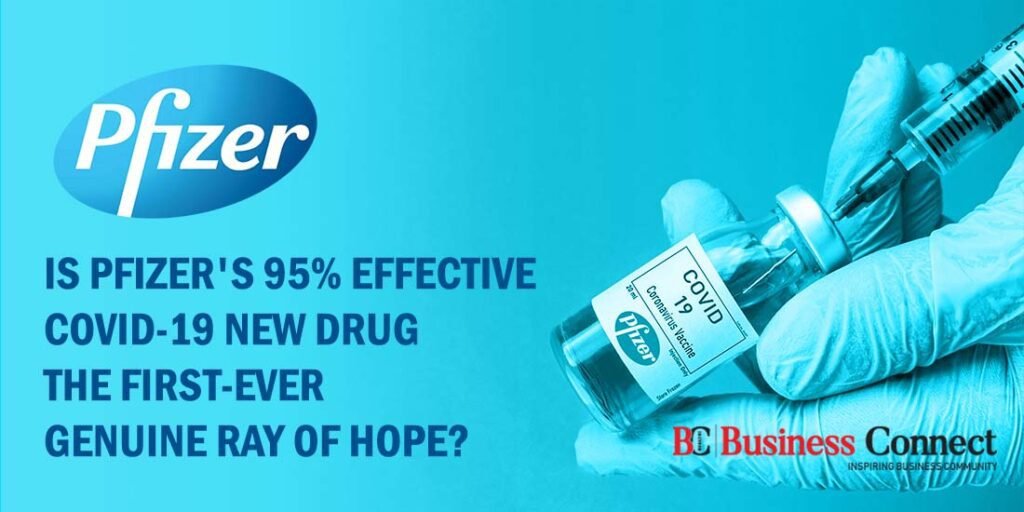Is Pfizer’s 95% effective COVID-19 new drug the first-ever genuine ray of hope?
Pfizer India will provide medicines worth Rs 516.16 Crore in India, and it is also in talks with the Indian government about allowing the use of its Covid vaccine in the country.
India is on the verge of expanding its “vaccine basket” as the deadly Covid-19 second wave in India has wreaked havoc on major cities such as Delhi, Mumbai, Kolkata, Lucknow, and Pune. Because hospitals and crematoriums are at capacity, funerals are being held in parking lots.
Is it too little, too late? Government of India’s new policy has paved the way for Pfizer (American Pharmaceutical MNC), Moderna, and Johnson & Johnson Covid-19 vaccines. India already has authorized Russian Sputnik V vaccines, which are being produced in partnering with community pharmaceutical companies.
Pfizer, one of the premier biopharmaceutical companies, was one of the elite manufacturers to seek for an emergency utilization authorization in India in December 2020. At the same time, the Serum Institute of India’s (SII) Covishield [ChAdOx1 nCoV- 19 Corona Virus Vaccine (Recombinant)], which is essentially the AstraZeneca vaccine, and India’s indigenous Covaxin had both applied for approvals. The fact that Pfizer’s vaccine must be stored at ultracold temperatures, necessitating the use of a specific cold storage mechanism that was not widely available in India, posed a significant barrier to approval. And so Pfizer withdrew its plan to launch its vaccines in India in February 2021.
With the recent Corona (SARS COV2) and its multiple variants attack on the right foot, specifically in major cities of India, Government has been compelled to launch multiple vaccines authorized across many countries, with more likely to follow soon. Although this is an inarguably joyful announcement, many people are concerned that vaccines will be developed with obvious haste. Pfizer/BioNTech MNC’s created COVID-19 (SARSCOV2) Vaccine was the maiden authorized vaccines in the “Western economies”. What do we know about it? Is it truly safe, and how does it work?
How Pfizer COVID-19 Vaccine works?
Pfizer/COVID-19 BioNTech’s vaccine – BNT162b2 – is an mRNA vaccine. It contains mRNA for the SARS-CoV-2 surface spike protein, which is protected by a lipid envelope. After the first dose is administered, the cells produce the viral spike protein by the mRNA instructions.
The particles, however, are recognized as foreign by the immune system, and the body begins to produce antibodies that specifically recognize the viral spike protein1. To obtain the best possible protection from the vaccine, each person is given two doses 21 days apart. Our immune system is boosted by the second round of vaccinations. This ensures that when the real SARS-CoV-2 virus enters our bodies, our immune system will recognize the pathogen and be able to fight it, effectively protecting COVID-19.
Are mRNA Vaccines safe?
While mRNA vaccines have not previously been used, this is not due to any safety concerns. They cannot give someone COVID-19 because they do not use a live virus. Another common misconception is that mRNA can affect our DNA. However, because mRNA does not even reach the cell nucleus, where our DNA is stored, it cannot interact with our DNA and is degraded shortly after the cell produces the spike protein.
Is the Pfizer/BioNTech vaccine effective and safe?
Data from the Phase 3 clinical trial showed that the vaccine was effective in 95 percent of participants who had never been infected with SARS-CoV-2. In the trial, BNT162b2 was generally well-tolerated, with no grave safety risks.
A novel Y501N mutation has recently emerged, first identified in the United Kingdom but rapidly spreading throughout the world. It affects the coronavirus spike protein, raising concerns about the efficacy of vaccines designed to recognize the spike protein (such as the Pfizer/BioNTech vaccine). However, preliminary research indicates that the Pfizer/BioNTech vaccine is capable of neutralizing these mutant versions of the virus.
Plans for approval and vaccination
The Medicines and Healthcare Products Regulatory Agency in the United Kingdom granted BNT162b2 a temporary authorization for emergency use against COVID-19 on December 2, 2020. It was swiftly followed by conditional authorization in Canada and authorization for emergency use in the U.S. The European Commission granted conditional marketing authorization to the BNT162b2 vaccine on December 21, 2020, making it available to all EU member states under the brand name Comirnaty.
U.S., U.K., Singapore, Republic of Costa Rica, Chile, Ecuador and Panama are among the countries that have approved the Pfizer/BioNTech vaccine. Some countries have already begun vaccinating their citizens; while it is too early to assess the vaccine’s effectiveness, it can be stated that the vaccine is generally well-tolerated. If in India Pfizer is able to get a quicker clearance and export freedom, it would produce Covid vaccine.
Drawbacks of Pfizer Vaccine
Pfizer Vaccine, also called the COVID-19 “Western Vaccine”, has some limitations. One example is the strict temperature requirements for shipping and storage, which must be kept at -70°C. Once thawed, it must be diluted and consumed within 6 hours. These unusual vaccine storage conditions complicate the entire vaccination process.
Cost of Pfizer Vaccine
Then there’s the price per dose, which is expected to be Rs 2700 in India, which is higher than the price of most competitors’ vaccines. Finally, there is a critical issue with the equitable distribution of the limited number of vaccines available.
Nonetheless, with many countries on the verge of healthcare crises as a result of a record surge in COVID-19 cases, it is past time for a well-tested, safe, and effective COVID-19 vaccine. Recently, the launch of combo of novel COVID-19 vaccines which are effective against Corona Virus and its mutant variants (double mutant and triple mutant variant), have made the conditions favourable and hopefully very soon in the coming future we may have a superior chance to win over the COVID-19 epidemic.



